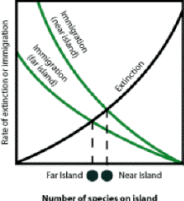 Saving Habitat
Saving HabitatTuesday & Thursday Week 12
 Saving Habitat
Saving Habitat
Tuesday & Thursday Week 12
Tuesday Announcements:
News Item: High Country News article of 11/13/2006 - Saving rare species without saving their habitat?
read the article, and the two (short) related articles linked at the end, for class on Thursday 11/15
Start thinking about possible debate topics - we'll discuss some in class Thursday
Moodle Quiz #4 next week...
Final Exam - Remember! The final will be cumulative; you must pass the final to pass the course; you may bring 1 page of notes to help you on the final. Exam day & time: Tuesday 4/28/09, 2:15-4:15, rm BH 235
Tuesday - Question of the Day: What can we do to save habitats?
Question 1: What's better for establishing habitat preserves -
many, small ones?
few, large ones?
Generate pros & cons in your groups (Round-Robin write)
Question 2: What does academic biology have to offer on this topic?
Island Biogeography Theory (MacArthur & Wilson)
What two processes are going to determine the total number of species present in a piece of habitat (OR on an island)?
Address these questions in your groups:
Effects of island size:
For a set of islands of different sizes, what would be the relative number of species each could support?
Which of the two processes discussed above would be most affected by island size?
What would this difference look like, on the figure? Draw your best attempt at this figure with your group...
Effect of island size:
Effects of island distance from mainland:
For a set of islands found at different distances from the mainland, would you expect a difference in the total number of species each could support?
Which of the two processes discussed above would be most affected by island distance?
What would this difference look like, on the figure? Sketch your own version of this figure with your group.
Effect of distance:

Question 3: What is the ideal reserve design?
See Powerpoint for MORE cool stuff on this topic!!
Primack, Figure 4.6 (p 202)
Be able to explain which scenario is better and why (use the figures below, but also refer to Primack's figure - more detail)
Better: Worse:
source: www.wildlands.org/
l_intro.html
Biosphere Reserves:
Source - http://www.unesco.org/mab/BRs.shtml
Biosphere reserves are much like laboratories where new and optimal practices to manage nature and human activities are tested and demonstrated. They outpace traditional confined conservation zones, combining core protected areas with zones where sustainable development is fostered by local dwellers and enterprises. Their governance systems are often highly innovative. In some cases, new legislation can be introduced. Biosphere reserves have three inter-connected functions:
- Conservation: landscapes, ecosystems, species and genetic variation
- Development: economic and human and culturally adapted
- Logistic support: research, monitoring, environmental education and training
This international network now includes 391 Biosphere Reserves in 94 countries. The Biosphere Reserve concept promotes management involving all local stakeholders to harmonize what at first often appear to be conflicting goals: nature conservation, economic development and cultural values. All Biosphere Reserves strive to pursue objectives in support of these goals in a complementary and balanced way:
- Nature conservation: conserve the diversity of species and the ecological integrity of local ecosystems.
- Economic development: encourage the sustainable development of local resources, both natural and human.
- Cultural enrichment: provide education, research and training supportive of conservation and sustainable development.
What have we done in the United States to preserve Biological Diversity?
28% of land area is Federally managed, mostly in the West & Alaska
4% of land area = in Wilderness (106 million acres), >50% in AK
plus millions of acres of less-protected land in National & State Parks, Wildlife Refuges, etc.
Organization of Federal Agencies that manage land, are charged with preserving species and/or habitat
How successful have we been? National Parks are a unique idea in the world - first parks were in US
Preservation of large mammals?
from: Newmark 1995; "Extinction of Mammals in N.Parks"
Do we manage for species or for habitat?
What legislation is in place for biological conservation?
NEPA
ESA